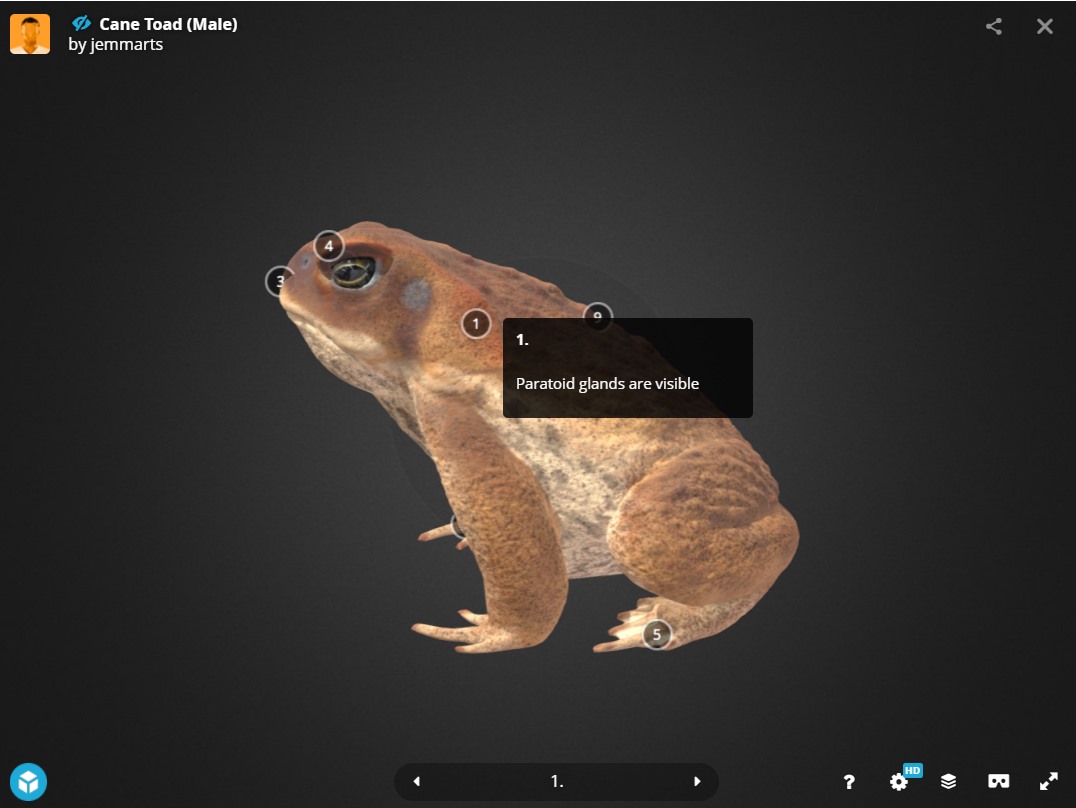Cane toads and native frogs
Is it a cane toad or native frog?
Cane toads are an introduced pest, and native frogs are protected. It is common for native Australian frogs to be
misidentified as cane toads. Here is some information and photographs of cane toads and some native frogs species, found in areas where cane toads might occur. If you have found an animal and are unsure of which species it is,
please contact your local authorities for assistance with identification.
CANE TOAD
Scientific name - Rhinella marina (formerly Bufo marinus) (introduced pest)
Click here to listen to their call
/CT2%20adult%20labels%20NSW%20DPI%20brochure.jpg)
If you think you have found a cane toad, make sure you contain the animal (if it is safe to do so) and submit a clear
picture with your report using the ToadScan
Map. We will help to confirm the species for you where we can, and provide advice on who to contact next.
Click on the image below to view a 3D cane toad

ADULT CANE TOADS
Large amphibian
Adult toads are usually between 10-15cm long. The largest female recorded was 24cm and 1.3kg in
Queensland.
Poison glands
Adults have large poison glands behind each ear.
Colour (from above)
Colour include grey, yellow, olive and brown to reddish brown.
Colour (from beneath)
Cane toads are usually cream and sometimes have a marbled pattern on their underside.
Bony ridges
Cane toads have bony ridges above their eyes and along the nose that join at the front of the head.
Feet shape
Cane toads do not have webbing between their front toes, however, they do have leathery webbing between their back toes. They do
not have wide pads on the ends of their toes and cannot climb vertical surfaces.
Adult male
Tends to have rougher skin than females, are smaller in size and generally yellowish in colour.
Adult female
Have smoother skin than males and are much larger in size.
Movement
Cane toads sit upright and move in short rapid hops.
Behaviour
Cane toad are a nocturnal foraging species. During the day or extreme cold and hot weather conditions, cane toads may be found sheltering under rocks and logs, in depressions and under
vegetation.
Breeding duration
Cane toad breeding is from September-March or when water temperature reaches 25oC.
.
Breeding location
Cane toads will congregate around water sources during breeding activity. The spawn is often angled over rocks or water plants.
Cane toad Amplexus
Breeding may occur twice per year.
EGGS AND TADPOLES
Eggs on lilypad
Distinctively different to native frog eggs which appear as a white floating foam, cane toad eggs are laid in long chains with a bead-like appearance.
Double strand eggs
Cane toad eggs are encased in a toxic tube of jelly often with two tubes laid next to one another.Eggs hatch after three days.
Egg mass
Usually containing 8,000 to 35,000 eggs in one clutch. Females can lay up to 2 clutches per year.
Egg hatching
Cane toad eggs will hatch in 24-72 hours.
Tadpole colour and shape
Cane toad tadpoles are small and jet black. They have a plain, dark bluish grey or black belly. Many native
frog species will be brown- very dark brown and have other marking, spots or semi transparent bodies.
Tadpole swarming
Cane toad tadpoles tend to school together in large groups, unlike most native tadpoles. Do not usually seek out shelter and can
be seen flicking their tails when stationary.
Tadpole length
Body length usually about 11mm, with total length of up to 30mm (head to tail tip). Tails are usually about 1.5
times longer than the body, are thin and tapered at the ends. Their body is oval shaped, widest at the gills and slightly
pointed at the snout.
Juvenile cane toad
Small in size and dark in colouration, with colours appearing as they get older. Juveniles tend to have smoother skin to adult toads. The parotoid glands on either side of their heads may be difficult to see. There may be a strip down the centre of their backs, similar to some native frogs.
Cane toad juveniles
Juveniles will sit upright and congregate around water, grassy areas and rockeries. They are active during the night and day.
Cane toad juveniles
Their eyes will have a distinctive football shape pupil with a ridge over the top, although you may need a
magnifying glass to see these features.
AUSTRALIAN NATIVE FROGS (Protected species)
Spotted Marsh Frog
(Limnodynastes tasmaniensis)
Eastern Banjo Frog
(Limnodynastes dumerilii)
Peron's Tree Frog
(Litoria peronii)
Tusked Frog
(Adelotus brevis)
Ornate Burrowing Frog
(Platyplectrum ornatum)
Striped Burrowing Frog
(Cyclorana alboguttata)
Find out more about Australian native frogs
Frogs of Australia website
FrogID website
Record Cane Toad Activity